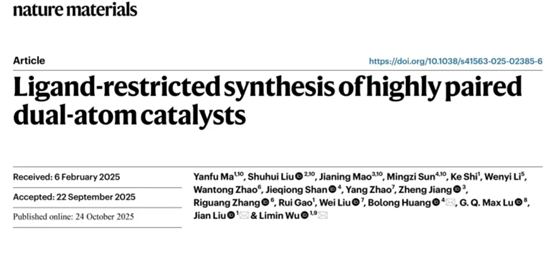Atomically dispersed metal catalysts have attracted significant attention in heterogeneous catalysis due to their well-defined structures and near-100% metal atom utilization. Among them, dual-atom catalysts (DACs) stand out for their higher metal loading capacity, tunable heteroatomic combinations, and unique microenvironments, offering catalytic performance that far exceeds that of single-atom catalysts. However, a major bottleneck has been the uncontrolled distribution, unpredictable spacing, aggregation tendencies, and low pairing efficiency of dual-metal sites.
Recently, Professor Wu Limin from the Institute of Energy and Materials Chemistry and Professor Liu Jian from the School of Chemistry and Chemical Engineering at Inner Mongolia University, in collaboration with Professor Huang Bolong from City University of Hong Kong, proposed an innovative ligand-restriction strategy to overcome these limitations. This method leverages non-covalent organic–inorganic interactions between diamines and g-C₃N₄, along with coordination interactions between diamines and bimetallic precursors, to effectively confine the pairing process and spatial arrangement of metal atoms on the g-C₃N₄ support.
This “anchoring–confinement” mechanism fundamentally suppresses the disordered migration of metal atoms and guides their directional pairing, thereby ensuring high structural pairing rates and stability.
Furthermore, the interatomic distance between paired atoms can be precisely tuned from 0.22 to 0.81 nm by selecting different diamine ligands (e.g., ethylenediamine, hexanediamine, or aromatic diamines). This offers a highly controllable pathway for tailoring the structure–function relationships of DACs.
This groundbreaking research not only provides a novel strategy for the precision synthesis of atomic-scale catalytic materials, but also offers critical insights into the nanoscale reaction mechanisms of heterogeneous catalysis.
The findings were published online on October 24 in the top-tier international journal Nature Materials, under the title “Ligand-restricted synthesis of highly paired dual-atom catalysts.”
Ma Yanfu, a postdoctoral fellow at Inner Mongolia University, is the first author, with Professors Wu Limin, Liu Jian, and Huang Bolong serving as co-corresponding authors. This achievement marks another landmark contribution by Inner Mongolia University in the field of advanced materials and catalysis science.


